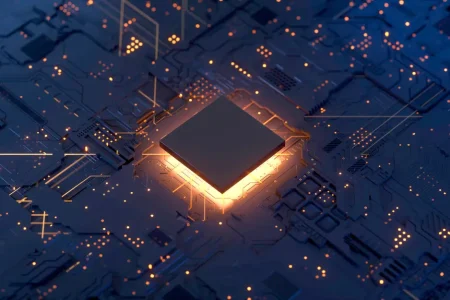The first optical “hidden” memory of computers in the world, which stores light instead of electricity and may in the future allow the ejection of computing power, changing the very architecture of chips and computer systems, was created by a research team of the Aristotle University of Thessaloniki (AUTh).
The new cache “builds” on the legacy created by the same team, when a few years ago it did the experimental demonstration of the fastest optical RAM in the world. Both achievements are still several years away from their possible marketing as commercial products, as the researchers point out to ANA-MPA, but they lay the foundations for solving one of the most important and long-lived problems of computers, the one described as the “Wall of Memory“: namely the fact that the speeds of memories in computers are increasing at a much slower rate than those of processors, resulting in an ever-increasing gap in their performance.
“This is a very radical idea, because we are moving away from the usual and traditional computer architecture. We implemented the memory and confirmed the principle of its operation, but in order for it to come out on the market it will have to go through a process. The current memory we created may for the first time store 16 bits in a fully addressable visual memory architecture, but we see that there is a prospect of reaching thousands of bits as well.To achieve this, further research at the level of photonic integration would be needed in order to reach a new type of chip. This would require five to ten years on its own, so that our research can then evolve into a product”, explains to ANA-MPA the researcher Theoni Alexoudis, member of the research team of Wireless and Photonic Systems and Networks WinPhos of AuTh, together with the PhD candidates Christos Pappas and Theodoros Moschos, the researcher and doctor Christos Vagionas and and the associate professor of the Department of Informatics of the Aristotle University of Thessaloniki, Nikos Pleros.
But why is it important to create this memory? What would be its applications in practice? According to Theoni Alexoudi, the creation of this memory – funded by two programs of the General Secretariat for Research and Technology and the Hellenic Foundation for Research and Innovation – can have a practical application in supercomputing systems and rooters.The main advantage is that optical memory does not need to be placed on the same chip as processors, which means that valuable living space, currently occupied by “traditional” memory, can be ensured for computational and operations functions. “In proportion to the space released from memory and attributed to the processors in the chip, we can have a very significant increase in computing power, by 40%, 50% or 60%,” she says, pointing out that for the first time, it is possible to use up to 100% of the chip’s capacity exclusively for calculation and operations in the future.
The experimental prototype of the cache developed at the Aristotle University of Thessaloniki demonstrates for the first time incomparable, for the scientific community, data reading and recording speeds of 20Gb/s (gigabits/second) per cache line, i.e. 20 billion binary digits in one second.The research was recently announced at the World International Conference on Visual Communications, in San Diego, USA, while the innovative research ideas of the AUTh team are funded by the Hellenic Foundation for Research and Innovation (HFRI) and the General Secretariat for Research and Technology (GSRT), through the research projects “CAM-UP – Visual Memories of Content Access for Quick Address Search” and “ORION – Visual Memories of Random Access with Low Energy Consumption for fast response and high rate performance in computational environments.

